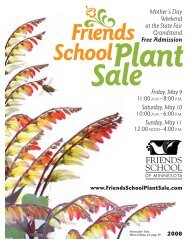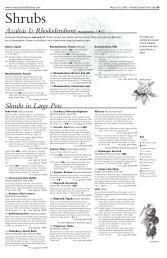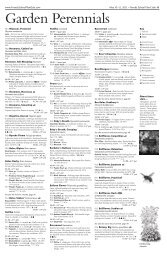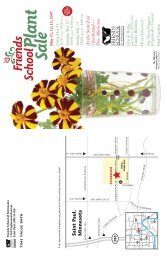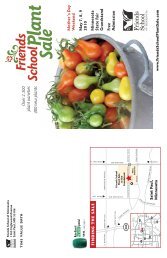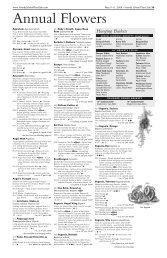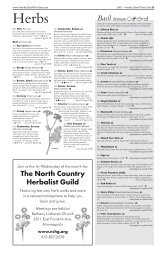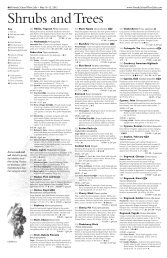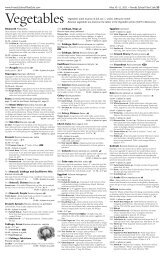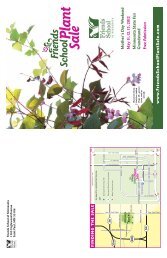2005 Catalog (PDF: 2.9MB) - Friends School Plant Sale
2005 Catalog (PDF: 2.9MB) - Friends School Plant Sale
2005 Catalog (PDF: 2.9MB) - Friends School Plant Sale
Create successful ePaper yourself
Turn your PDF publications into a flip-book with our unique Google optimized e-Paper software.
<strong>2005</strong> • <strong>Friends</strong> <strong>School</strong> <strong>Plant</strong> <strong>Sale</strong> 5<br />
Gardening with Natives<br />
BY SARA BARSEL<br />
Native plants have adapted over<br />
thousands of years to our local<br />
growing conditions: climate<br />
patterns, such as rainfall, wind, sunshine,<br />
and temperature, pollinators,<br />
and soil types. Because they are<br />
adapted to local conditions, native<br />
plants survive variations in local<br />
climates, such as droughts and<br />
extreme temperatures, and are<br />
easier to grow and maintain than<br />
many non-native or exotic plants.<br />
Native plants grown from seed<br />
that has been collected in the<br />
same area where the new plants<br />
will grow will be best adapted to<br />
their environment. In other<br />
words, plants grown from seed<br />
harvested in Minnesota will grow<br />
better in Minnesota than plants<br />
grown from seed harvested in South<br />
Carolina and planted in Minnesota.<br />
The joys and virtues of native plant<br />
gardening include:<br />
• Promoting biodiversity by providing<br />
food, nectar, cover, and nesting areas<br />
that local birds, insects, and mammals<br />
need to survive.<br />
• Improving water quality, stabilizing<br />
soil and reducing erosion. Many prairie<br />
plants have extensive root systems,<br />
enabling them to filter stormwater, survive<br />
drought, and improve soil fertility.<br />
• Conserving water. Many native<br />
plants are drought-resistant, once<br />
established.<br />
• Reducing use of fertilizers. Many<br />
native plants do not require any<br />
fertilizers.<br />
• Reducing use of pesticides. Many<br />
native plants are disease-resistant or<br />
disease-tolerant.<br />
• Reducing the need for frequent<br />
replanting. Most native plant species are<br />
perennials or self-sowing biennials that<br />
reseed themselves.<br />
The responsibilities of native plant<br />
gardening include:<br />
• Purchasing native plant seeds or<br />
plants from reputable nurseries or<br />
organizations.<br />
• Not removing native plants from<br />
places they naturally inhabit because it<br />
depletes the natural area of these plants.<br />
• Leaving sufficient seed in any area<br />
for the plants to replenish themselves<br />
when seed harvesting.<br />
Gardening with native plants<br />
Gardening with native plants can be<br />
as formal or informal as you choose. You<br />
can combine native plants with cultivated<br />
plants in your garden. There are no<br />
rules. You do not have to recreate a<br />
prairie or other landscape in order to<br />
garden with native plants. (See page 38<br />
for information on starting a rain garden<br />
with native plants.)<br />
Gardening with native plants is similar<br />
to gardening with cultivated annuals<br />
and perennials. To be successful, you<br />
must pay attention to the growth<br />
requirements of each native plant, such<br />
as light requirements, moisture needs,<br />
soil type, or salt-sensitivity. In other<br />
words, gardening with native plants<br />
follows the same common sense rules as<br />
gardening with any other plants.<br />
Native<br />
plants<br />
require one or<br />
two seasons to<br />
become established in<br />
your garden, so even<br />
“drought-resistant” plants will<br />
need to be watered during their<br />
first growing season(s).<br />
<strong>Plant</strong> suggestions<br />
Here are a few suggestions for native<br />
plants to include in your gardens:<br />
• For butterfly gardens: milkweeds,<br />
blue false indigo, coreopsis, purple<br />
coneflower, meadow blazingstar, Joe Pye<br />
weed, boneset, cardinal flower, vervain,<br />
ironweed, columbine, turtlehead, lupine,<br />
penstemon, New Jersey tea, lead plant,<br />
butterfly weed, rattlesnake master, and<br />
blanketflower.<br />
• To attract birds and hummingbirds:<br />
aster, blue false indigo, purple prairie<br />
clover, coneflower, sunflower, blazingstar,<br />
penstemon, cup plant, sweet<br />
black-eyed Susan, goldenrod, cardinal<br />
flower, great blue lobelia, Turk’s cap lily,<br />
monkey flower, columbine, larkspur, royal<br />
catchfly, bee balm (bergamot), compass<br />
plant, New Jersey tea, prairie phlox,<br />
wild petunia, iris, and grasses: little<br />
bluestem, prairie dropseed, Indian grass,<br />
sideoats grama.<br />
Shrubs to provide nectar, berries,<br />
browse, and protective thickets for hiding:<br />
blueberries, highbush cranberries,<br />
snowberries, elderberries, viburnum,<br />
chokeberries, dogwood, and serviceberries.<br />
<strong>Plant</strong>s for shade or semi-shade:<br />
columbine, Jack-in-the-pulpit, red<br />
baneberry, white baneberry, wild ginger,<br />
shooting star, larkspur, false rue<br />
anemone, sweet Joe Pye weed, wild<br />
geranium, Virginia bluebells, bishop’s<br />
cap, Jacob’s ladder, Solomon’s seal,<br />
foamflower, meadow rue, blue cohosh,<br />
hepatica, May apple, blood root, zig-zag<br />
goldenrod, trillium, bellwort, and spring<br />
beauty.<br />
Prairie plants: sweet flag, fragrant<br />
hyssop, prairie onion, milkweeds, leadplant,<br />
Canada May flower, thimble<br />
flower, Pasque flower, pussytoes, prairie<br />
sage, aster, Canada milkvetch, ground<br />
plum, wild indigo, harebells, partridge<br />
pea, New Jersey tea, turtlehead,<br />
coreopsis, prairie larkspur, coneflower,<br />
rattlesnake master, gentians, prairie<br />
smoke, blazingstar, penstemon, prairie<br />
clover, prairie phlox, black-eyed Susan,<br />
compass plant, cup plant, goldenrod,<br />
violets, culver’s root, vervain, ironweed,<br />
Joe Pye weed, boneset, steeplebush,<br />
meadowsweet, blue-eyed grass, and wild<br />
petunia.<br />
Native grasses: big bluestem, little<br />
bluestem, sweet grass, side oats grama,<br />
blue grama, Canada wild rye, prairie<br />
dropseed, bottlebrush grass, Junegrass,<br />
Indian grass, and prairie cord grass.<br />
Resources<br />
Your local library and many plant<br />
catalogues are excellent sources of<br />
information. In addition, these Web sites<br />
contain excellent information, pictures,<br />
links, and local events.<br />
North American Native <strong>Plant</strong> Society<br />
www.nanps.org/index.shtml<br />
Minnesota Native <strong>Plant</strong> Society<br />
www.mnnps.org<br />
Sara Barsel has been enthusiastically<br />
gardening with native and cultivated plants<br />
in the Midwest for many years.<br />
The Minnesota Native <strong>Plant</strong> Society is a nonprofit charitable<br />
organization founded in 1982. The Society is dedicated to the<br />
study, appreciation, preservation and restoration of Minnesota’s<br />
native plants and plant communities. Our membership includes<br />
a diverse cross section of native plant enthusiasts, such as<br />
professional botanists and ecologists, native plant gardeners and<br />
growers, college and high school students, and university professors.<br />
The Society meets monthly at the Minnesota Valley National<br />
Wildlife Refuge in Bloomington. We hold several field trips each<br />
year, as well as a native seed exchange in November and a native plant<br />
sale in June. Our meetings are open to the public. Please come visit<br />
us at our monthly meetings, or visit www.mnnps.org for more<br />
information regarding the Minnesota Native <strong>Plant</strong> Society, upcoming<br />
programs, field trips, and memberships.





